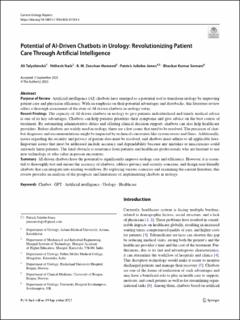| dc.contributor.author | Talyshinskii, Ali | |
| dc.contributor.author | Naik, Nithesh | |
| dc.contributor.author | Hameed, B. M. Zeeshan | |
| dc.contributor.author | Juliebø-Jones, Patrick | |
| dc.contributor.author | Somani, Bhaskar Kumar | |
| dc.date.accessioned | 2024-01-16T09:49:27Z | |
| dc.date.available | 2024-01-16T09:49:27Z | |
| dc.date.created | 2023-10-27T09:36:57Z | |
| dc.date.issued | 2024 | |
| dc.identifier.issn | 1527-2737 | |
| dc.identifier.uri | https://hdl.handle.net/11250/3111720 | |
| dc.description.abstract | Purpose of Review
Artificial intelligence (AI) chatbots have emerged as a potential tool to transform urology by improving patient care and physician efficiency. With an emphasis on their potential advantages and drawbacks, this literature review offers a thorough assessment of the state of AI-driven chatbots in urology today.
Recent Findings
The capacity of AI-driven chatbots in urology to give patients individualized and timely medical advice is one of its key advantages. Chatbots can help patients prioritize their symptoms and give advice on the best course of treatment. By automating administrative duties and offering clinical decision support, chatbots can also help healthcare providers. Before chatbots are widely used in urology, there are a few issues that need to be resolved. The precision of chatbot diagnoses and recommendations might be impacted by technical constraints like system errors and flaws. Additionally, issues regarding the security and privacy of patient data must be resolved, and chatbots must adhere to all applicable laws. Important issues that must be addressed include accuracy and dependability because any mistakes or inaccuracies could seriously harm patients. The final obstacle is resistance from patients and healthcare professionals who are hesitant to use new technology or who value in-person encounters.
Summary
AI-driven chatbots have the potential to significantly improve urology care and efficiency. However, it is essential to thoroughly test and ensure the accuracy of chatbots, address privacy and security concerns, and design user-friendly chatbots that can integrate into existing workflows. By exploring various scenarios and examining the current literature, this review provides an analysis of the prospects and limitations of implementing chatbots in urology. | en_US |
| dc.language.iso | eng | en_US |
| dc.publisher | Springer | en_US |
| dc.rights | Navngivelse 4.0 Internasjonal | * |
| dc.rights.uri | http://creativecommons.org/licenses/by/4.0/deed.no | * |
| dc.title | Potential of AI-Driven Chatbots in Urology: Revolutionizing Patient Care Through Artificial Intelligence | en_US |
| dc.type | Journal article | en_US |
| dc.type | Peer reviewed | en_US |
| dc.description.version | publishedVersion | en_US |
| dc.rights.holder | Copyright 2023 The Author(s) | en_US |
| cristin.ispublished | true | |
| cristin.fulltext | original | |
| cristin.qualitycode | 1 | |
| dc.identifier.doi | 10.1007/s11934-023-01184-3 | |
| dc.identifier.cristin | 2189051 | |
| dc.source.journal | Current Urology Reports | en_US |
| dc.source.pagenumber | 9-18 | en_US |
| dc.identifier.citation | Current Urology Reports. 2024, 25, 9-18. | en_US |
| dc.source.volume | 25 | en_US |

